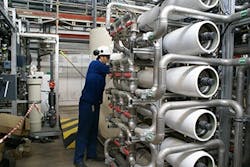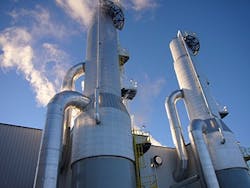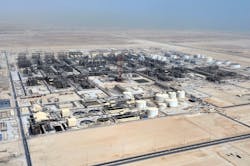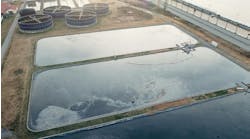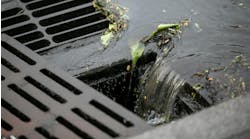Water optimization programs increasingly are focusing on zero liquid discharge (ZLD). Approaching or achieving that milestone may involve many different technologies. No single strategy suits every wastewater, note vendors such as Dow Water Solutions, SUEZ Water Technologies & Solutions, and Veolia.
“Water scarcity and stricter discharge limits are really putting industrial customers in a tough situation. Depending on the severity of the two sides of this equation, customers are being pushed to achieve minimal liquid discharge (MLD) or zero liquid discharge (ZLD) — and we are seeing a trend towards more and more ZLD,” says Tina Arrowood, lead research scientist, Dow Water Solutions, Edina, Minn.
The company offers a broad set of technologies to help reduce the cost and energy requirements of treating wastewater. These include ultrafiltration (UF), reverse osmosis (RO), nanofiltration (NF) and ion exchange (IX). The latest additions are the Fortilife CR100, XC70 and XC80 RO elements, which specifically tackle biological and organic fouling, and the XC-N ion-separation membrane, which enables recovery of a large fraction of salts.
Figure 1. Wastewater filter elements must contend with increasingly harsh environments. Source: Dow Water Solutions.
“We’ve really focused product development on technologies that convert large quantities of wastewater into purified, reusable water. RO elements are a fantastic technology for this and are much cheaper than using thermal distillation technologies. Our new filter elements are key to achieving high water recovery from high total dissolved solids (TDS) wastewater, leaving a high-quality permeate that is good enough for re-use,” she stresses.
Fouling resistance was a key theme in the development of the new elements; each is designed for the fouling potentials expected within the successive water recovery processes. In addition, the elements must be durable because these harsher, more-fouling environments require more cleaning (Figure 1). Both the membranes and the spiral wound module itself must withstand exposure to extreme pHs, too. Also important is using the elements at a point in the concentration process where membrane separation efficiency is maximized.
“The bottom line is: ‘Can we concentrate and maximize water removal from the wastewater stream and reduce the amount of water going either to downstream processes such as thermal treatment, or to discharge?’” she explains.
The biggest push towards MLD and ZLD is coming from chemical manufacturers in Northern China and Indian textile producers, two regions posing the twin challenges of water scarcity and discharge restrictions, according to Arrowood. Meanwhile, the power industry increasingly is embracing the approach because of its fluegas desulfurization (FGD) processes. Other pockets also exist, particularly in North America and Europe; there, regulations and corporate sustainability goals, either singly or in tandem, are driving demand in the chemical, and petrochemical sectors as well as among food and beverage makers.
As an example, she cites a project in the coal-to-chemical industry in Northern China, where a large chemical complex typically generates more than 1,500 m3/h of wastewater with a total dissolved solids (TDS) level ranging from 1,000–2,000 mg/L. The plant was recovering and recycling over 65% of this water using conventional fouling-resistant RO products. However, it wanted to reclaim an additional 90% of purified water from the concentrate of the primary wastewater recovery system where TDS exceeds 5,000 mg/L. Deploying Dow Filmtec RO elements enabled the desired water volume reduction, significantly decreasing the cost of the downstream thermal dewatering process for achieving ZLD.
Figure 2. Meeting very low TDS discharge limits usually requires use of evaporators. Source: SUEZ Water Technologies & Solutions.
However, capital and operating costs for running a ZLD system represent only one challenge for a treatment plant of this size. Another is dealing with the about 40 t/d of final solid waste salts produced. The high TDS wastewater contains an unusable mixture of sodium sulfate, sodium chloride and a number of other trace contaminants. So, the plant installed a system with Fortilife XC-N elements to treat this complex salt mixture after being concentrated to above 50,000 mg/L using RO elements.
“More than 60% of this water was converted to a purified sodium chloride solution for reuse applications. Moreover, the 40 t/d of waste salts going to the landfill could be reduced by nearly half,” notes Arrowood.
Another example involves an industrial park in Asia with a common wastewater treatment facility that long has used RO to reduce the amount of water discharged to the environment in line with the facility’s strict discharge permit.
The industrial park hopes to expand by adding new manufacturing facilities. Increasing the wastewater discharge volume would require a new permit. So, the challenge was to recover and recycle even more wastewater while keeping within the existing discharge limit. Complicating matters, that water must be extremely low in both organics and TDS to be suitable for the sensitive production processes on the site.
Installation of Fortilife XC70 RO elements has allowed the facility to recover more reusable water and treat additional wastewater while staying within its discharge limit. This simple upgrade eliminated the wastewater treatment plant as the bottleneck for expansion.
“We are still far from the limits of the capability of XC70 technology in this project. We could add XC80 elements if we had to, or even ultra-high-pressure RO elements. So we have additional options in our toolbox to squeeze out more water before we need to consider the evaporation and crystallization processes required for ZLD,” Arrowood emphasizes.
However, RO is approaching its thermodynamic limits, posing challenges for technology development. In response, Dow is working to create synergies between its own membrane developments and other firms’ innovative process schemes such as closed-loop designs. “It’s important that there is convergence here to meet the demand for technologies that can achieve high water recovery in harsh industrial environments such as high operating temperatures and pHs,” she adds.
Three Key Points
“The primary driver for going all the way to ZLD is regulation/local government mandates. Then there is public perception, so we are seeing more and more desire for good stewardship and being proactive before any new regulations come in. In fact, many companies are now specifying wastewater recovery and ZLD systems in projects in anticipation of the changing regulatory climate,” notes Bill Heins, global leader for market development, SUEZ Water Technologies & Solutions, Bellevue, Wash.
Three main points must underpin ZLD strategies, he advises. First, the key to continued innovation and process success lies in collaboration with the client. “All our developments are collaborative. We have to completely understand the process to come up with optimum solutions and products. That will be the face of improvement over the next 10–20 years,” he says.
Second, as Arrowood also notes, is the need to develop innovative designs that achieve still more water recovery even as the physical limits of processes such as RO are reached.
Third is economics, especially in areas where freshwater is at a premium and the cost to treat difficult-to-dispose-of wastewaters is increasing.
The implementation of a ZLD project depends on the specific operational challenges. For example, U.S. refineries must contend with five: ageing plants; decreasing freshwater availability; reduced source water quality, e.g., greater brackishness; crude variability; and stringent discharge limits.
Typically, membrane bioreactors handle organics in the wastewater stream. To meet TDS discharge limits, a plant usually will call upon technologies such as RO, electrodialysis, brine concentration and crystallization, either alone or in different combinations.
Figure 3. Effluent plant handles 12 different wastewater streams and provides five qualities of recycled water. Source: Veolia.
“In the situation where you have to meet very low TDS discharge guidelines, the ZLD design would definitely need evaporators (Figure 2) and crystallizers. Although they are higher-cost unit operations, they are the only way to meet very stringent discharge limitations,” he explains.
Also, operators must consider that discharge limits always are evolving. This has led some refineries to adopt the company’s ABMet process, which was originally developed to remove nitrates and selenium from wastewater streams in coal-fired power plants.
“The key to any project is always collaboration with the client. You need to understand all aspects of the process to devise the optimum treatment approach and, if five different operations are needed for the optimum approach and we only supply four of the technologies, we will work with other vendors to ensure that the best solution is implemented,” adds Heins.
As an example of how profound such collaboration can be, he cites a project with an oil sands company in Alberta aimed at recovering as much water as possible from heavy oil. SUEZ spent three years embedded with the company, gaining a thorough insight into every aspect of its processes. Together, they developed a now patented process that involves feeding the recovered water to an evaporator. The distillate from this then goes to a steam generator, leaving evaporator blowdown containing almost all solutes from the produced water feed. The high-quality high-pressure steam is injected downhole to heat the oil formation, fluidize the oil and allow it to be pumped to the surface.
“This totally new process has been installed at 25 other sites. It is a paradigm shift in the industry,” he says.
Manufacturers in India and China are particularly interested in ZLD systems, Heins agrees. In China, the drive is on to reduce the amount of mixed salt wastes going to landfill by instead producing purified salts that can be sold at a profit.
The 700-MW Jingneng Zhuozhou coal-fired power plant in Zhuozhou, installed a ZLD system that allows reuse of 99% of FGD blowdown wastewater and produces approximately 10.5 t/d of marketable purified industrial salt. The process begins with three stages of physico-chemical treatment, the last being UF to remove saturated solids. IX resins then take out the ions responsible for water hardness. The next step involves NF and RO. Permeate from RO goes to the cooling towers for reuse while RO reject passes to a thermocompressor-driven forced circulation crystallizer prior to solids dewatering, drying and packaging for sale.
SUEZ is particularly focused on improving NF and RO membrane systems; it is working on new glues and membrane backings to counter temperature and osmotic pressure limitations. One R&D project — a collaborative effort with a refining company — aims to develop RO membranes that can work at 90°C and in very high pH environments. It’s a strategy that could reduce or even eliminate the need for expensive heat exchangers in some circumstances.
Another project, spurred by the growing demand for lithium-ion batteries, looks at the recovery and purification of the lithium. “Here we are working on innovative membrane and thermal technologies which can operate in high TDS and high scaling environments,” Heins says.
However, companies intent on implementing ZLD and similar strategies can overlook one important issue — materials of construction, he cautions. “The production plant might be built for an operational life of 30+ years, but some of the salts we are recovering are very corrosive. So the treatment plant will need to use the optimum materials of construction to handle this — which can involve more capital expenditure.”
Thermal Treatment
Meanwhile, Veolia, Paris, is helping plants achieve ZLD by integrating its proprietary HPD evaporation and crystallization technologies for specific effluent demands.
Its biggest ZLD project to date is at Shell’s Pearl gas-to-liquids (GTL) project in Qatar. The onshore plant produces 140,000 bbl/d of GTL plus 120,000 bbl/d of associated condensate and liquefied petroleum gas.
Twelve different wastewater streams enter the 45,000-m3/d effluent treatment plant (Figure 3) at eight different locations. The plant must supply five different qualities of recycled water.
Veolia’s treatment strategy includes flocculation, aerobic biological treatment, submerged UF, RO, evaporation, crystallization and sludge dewatering.
UF and RO are used to return water to the GTL process. Meanwhile, RO brine treatment as well as evaporation and crystallization stages ensure that ZLD is achieved, leaving only salt behind.

